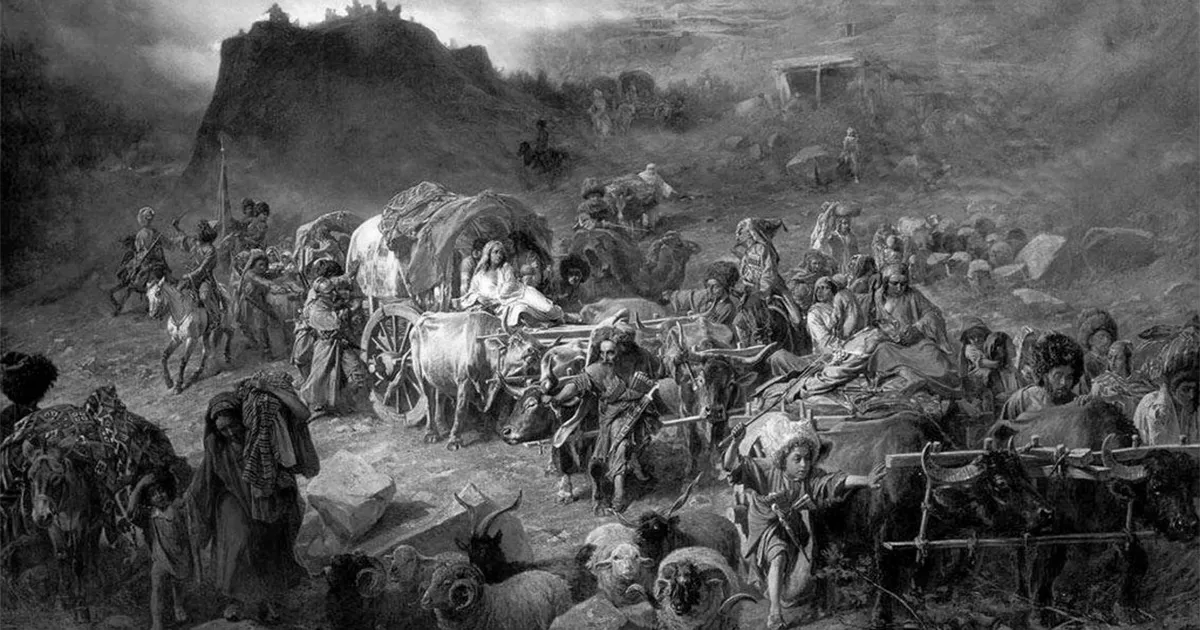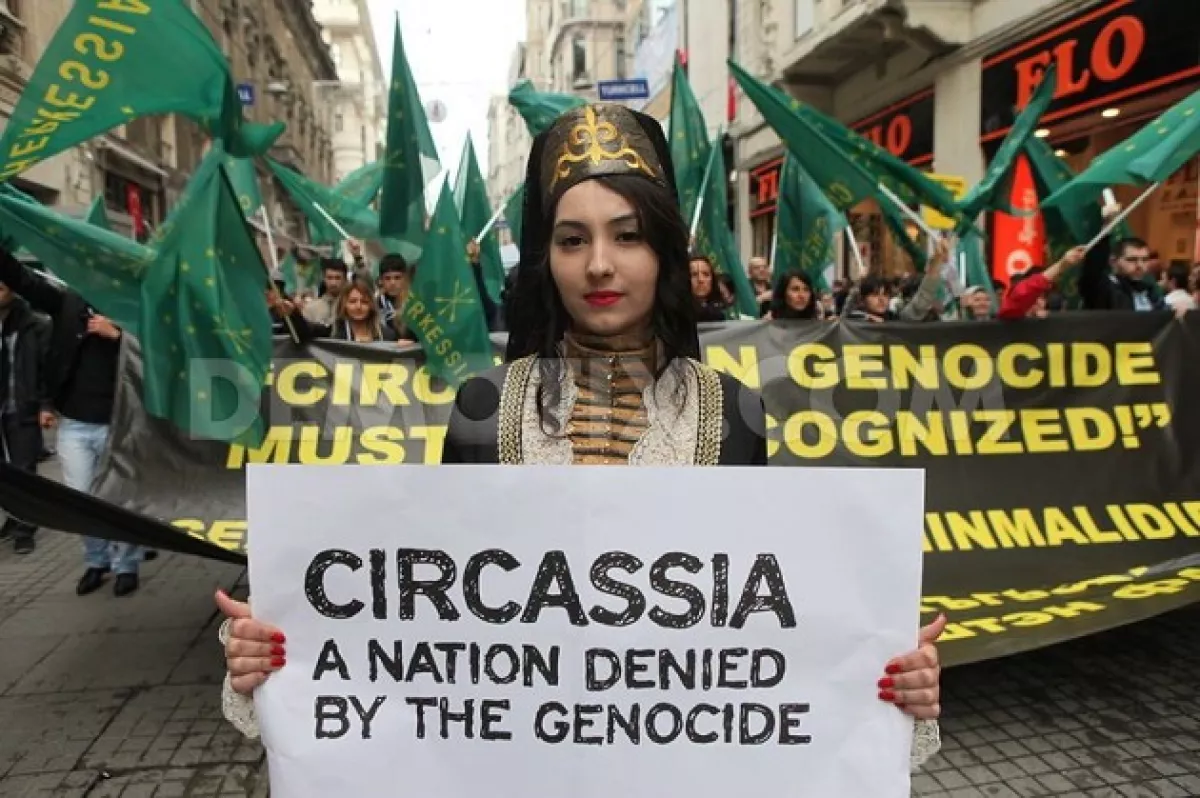No right to oblivion Caliber.Az on the tragedy of the Circassian people
The history of Russia’s conquest of the Caucasus is a chronicle of bloody expansion. Cloaked in the rhetoric of “bringing civilisation” and “establishing order,” the empire relentlessly advanced southward, encountering fierce resistance from peoples whose independence, land, and cultural identity became casualties of imperial ambition. The Caucasus — a region where dozens of ethnic groups, languages, and religions had coexisted for centuries — was turned into a theatre of unending wars, deportations, punitive expeditions, and ethnic cleansing. For the Russian Empire, it was a struggle for control over a strategic crossroads between Europe and Asia. For the peoples of the Caucasus, it was a fight for survival.
One of the symbols of this resistance was Imam Shamil, who, together with the peoples of the North Caucasus, waged a determined war against Russian expansion for decades. History remembers such battles as the defence of Gimry (October 17–18, 1832), the Battle of Akhoulgo (June and August 1839), the Battle of Dargo (May and July 1845), as well as numerous skirmishes in Chechnya and Dagestan during the 1850s. This was a confrontation not only against military force but also against the violence, repression, and humiliation brought by tsarist officials and military commanders.
The so-called Caucasian War — the Russian Empire’s military campaign to subjugate the North Caucasus — lasted nearly half a century, from 1817 to 1864, making it the longest war in Russia’s history. It ended in mass killings, forced expulsions, and the near-total destruction of entire Caucasian peoples. One of the most tragic chapters was the genocide of the Circassians — a crime of such scale and brutality that it ranks among the bloodiest crimes against humanity of the 19th century. Caliber.Az has previously covered this atrocity in one of its recent publications.
The killings, destruction, and displacement of the Circassians were acknowledged by none other than the great Russian literary figure Alexander Pushkin. In his essay A Journey to Arzrum, written between 1829 and 1835, he admitted: “Circassians hate us. We drove them out of the pastures…their ruined villages, whole tribes wiped out.”

A Russian military officer, major, and participant in the 1813–1814 Foreign Campaign of the Russian army, Decembrist Nikolai Ivanovich Lorer — who from May 1824 was a member of the Northern and later the Southern Societies — also took part in the Caucasian War. In his memoirs, he described the atrocities committed by Russian officers against the Circassians during the 1817–1864 campaign. He was especially critical of General Grigory Khristoforovich von Zass, notorious as an executioner of the Circassian people and a ruthless butcher.
The following excerpt is from Memoirs of the Decembrists, published in Moscow in 1988:
“Once we were visiting the general, and he was being unusually courteous with us — then suddenly disappeared. After waiting for him for quite some time, we inquired about our host and learned that he had gone beyond the Kuban, having received word that the mountaineers had gathered. In conversation with Zass, I remarked that I did not approve of his method of warfare, and he replied immediately: ‘Russia wants to conquer the Caucasus at any cost. How else to subdue the peoples who are our enemies, if not through fear and terror? Philanthropy has no place here. A.P. Yermolov, by hanging mercilessly, looting and burning the auls, succeeded far more than we have. To this day, his name is uttered with fear in the mountains and used to frighten small children.’
In support of the doctrine of fear preached by Zass, Circassian heads were constantly mounted on pikes atop a specially constructed mound near Prochny Okop. Their beards fluttered in the wind. It was a sorrowful and repulsive sight.
On one occasion, Zass invited Naryshkina to visit him, and she agreed on the condition that the enemy heads be removed. Zass fulfilled her request, and we all visited him as guests. Once, when I entered the general’s study, I was struck by an unbearable, repugnant stench. Laughing, Zass dispelled our confusion, saying that his men had probably placed a box of heads under the bed — and indeed, he pulled out a large chest containing several heads that stared at us with glassy eyes.
‘Why do you keep them here?’ I asked.
‘I boil and clean them,’ he replied, ‘then send them to various anatomical cabinets and to my professor friends in Berlin.’”
Russian democrats and publicists also wrote about the horrors that the war, unleashed by the tsarist regime, brought upon the mountain peoples of the Caucasus. This bloody confrontation resulted in enormous losses — including for the Russian people themselves. Nikolay Chernyshevsky noted the “tens of thousands of soldiers dying each year in the war in the Caucasus.” Upon learning of the cessation of hostilities in Chechnya and Dagestan, he wrote:
“Much is being said here about the capture of Shamil. A room has been prepared for him in the Tauride Palace, and in general, he will be received with great honour. After people have seen enough of him, he will be offered to settle either in Kazan or Kiev. Thank God, now the Caucasus will no longer consume 25,000 Russian soldiers every year…”
Russian General Ivan Mikhailovich Drozdov, in his memoirs The Final Struggle with the Mountaineers in the Western Caucasus, published in Tiflis in 1877, described in detail the events related to the expulsion of the Circassians, of which he was an eyewitness. Below are excerpts from his recollections:
“At the end of November (1863), the Pshekha detachment, under the command of His Imperial Majesty’s retinue Major General Grabbe, set out toward the upper reaches of the Sazha River. Along the way, forty families of mountaineers were taken prisoner. The next day, at two in the afternoon, we left our position and moved toward Goitkh. The prisoners accompanying the detachment, barely clothed in rags, were collapsing from exhaustion; mothers dropped lifeless infants from their arms. One’s heart ached at the sight of these wretched people, but there was no way to help them.
At the end of February, the Pshekha detachment moved toward the Marta River to monitor the expulsion of the mountaineers — and, if necessary, to drive them out by force. Advancing slowly — now to the right, now to the left, now upward — and destroying abandoned auls along the way, the detachment reached the headwaters of the Psekups River, from where it crossed the Caucasus ridge to its southern slope and halted at the confluence of the Chilipsi stream with the Tuapse River.

From there, only thirty versts (about 32 kilometres) remained to reach the Black Sea. Along the way, our eyes were met with a harrowing sight: scattered corpses of children, women, and the elderly — mutilated, half-devoured by dogs; migrants emaciated by hunger and disease, barely able to move their feet from weakness, collapsing from exhaustion and, while still alive, falling prey to starving dogs.
On May 28, 1864, the Caucasian War came to an end. The Kuban region was not only conquered, but also ‘cleansed.’ From what had once been a sizeable population, only a handful of people remained — resettled along the Kuban River. In late 1864 and throughout 1865, detachments marched again through all the newly conquered territories, driving out the remaining stray mountaineers, destroying the last bandit den on the southern slope, in Khakuchi, and finally, after laying down their battle armour, turned to peaceful pursuits.
Now, in the mountains of the Kuban region, one may encounter a bear or a wolf — but not a mountaineer. Thus ended the long, stubborn, and bloody struggle in the Caucasus. It was a hard time, but in such labour there was a certain satisfaction in testing one’s strength... And life did not pass meaninglessly: there was much allure in fierce combat, and the dry, sharp sound of a highland rifle shot stirred the soul more deeply than the voice of an Italian tenor. One feels an involuntary respect for an enemy who, despite being relatively few in number, could resist a giant for so many decades and die without a single cry of complaint.”
Walter Richmond — a professor of Russian culture and literature at Occidental College in Los Angeles and the author of The Circassian Genocide, a work based on rare archival materials dedicated to the history of the Caucasian War and the genocide of the Circassians. In his research, he presents the following facts concerning the tragedy of the Circassian people:
“If one takes into account the assertion by (Adolf) Berzhe that the figure of 470,000 is a serious underestimate of those deported, as well as the estimate by Turkish demographer Kemal Karpat that 2 million people were resettled between 1856 and 1876, then it can be stated with confidence that between 600,000 and 750,000 Circassians in 1864 indeed boarded ships bound for Turkey.
Even if only 10 per cent of those driven to the coast perished there (which is undoubtedly a low estimate), the total number of those who reached the shore rises to between 660,000 and 825,000 people.
As for those who died along the way — from the mountains to the Black Sea coast — considering reports that only 370 out of one detachment of 600 people reached the shore, and assuming a 10 percent mortality rate on this leg of the journey (which is also a gross underestimate), this suggests that at least 726,000 to 907,500 Circassians were driven down from the mountains. If we add another 10 per cent who perished while fleeing or hiding from Russian forces, the total rises to between 798,600 and 998,225 people.
Adding to this the Circassians who were killed in battles with Russian forces in the final years of the war, the estimate of the Circassian population in 1860 — between 1.25 and 1.5 million — becomes entirely plausible. This means that even by the most conservative estimates of mortality, at least 625,000 Circassians died during General Yevdokimov’s operations.
If we assume a population of 1.5 million in 1860 and an average annual growth rate of 2 per cent, the population of Circassia today would be around 30 million. In reality, however, the global Circassian population is estimated at only 4 to 6 million — with just 700,000 living within the borders of the Russian Federation.”

Even by modern standards, these figures are horrifying — let alone when compared to the population statistics of that era. Today, numerous tragedies and genocides are discussed on international platforms, yet the Circassian genocide stands out as one that is either ignored or deliberately silenced. To date, it has been officially recognised only by Georgia and Ukraine.
The Circassian diaspora is spread across many regions of the world — primarily in Türkiye, Syria, Jordan, the United States, and several European countries.
The genocide of the Circassian people is not merely a tragic chapter in history, but a living wound — one that still bleeds in the memory of millions. It was a crime committed under the banners of "civilisation" and "state order", leaving behind scorched earth, villages wiped off the map, shattered lives, and a people scattered across the globe.
The destruction of Circassia was not an accident or a military necessity — it was a deliberate, systematic extermination of a nation. Everyone who learns of this tragedy today becomes a witness — and with that comes a moral responsibility: to remember, and to speak out.
Until the truth about the Circassian genocide is acknowledged and brought to the attention of the international community, this story will remain not only a pain of the past but a moral challenge to the present.
By Ramil Alasgarov








